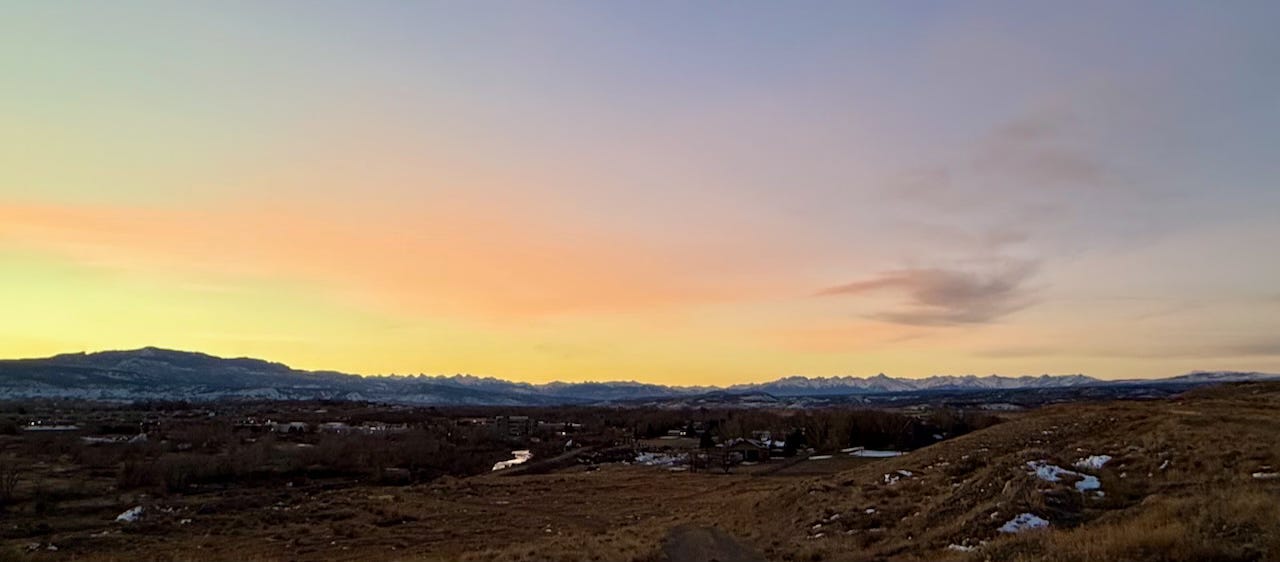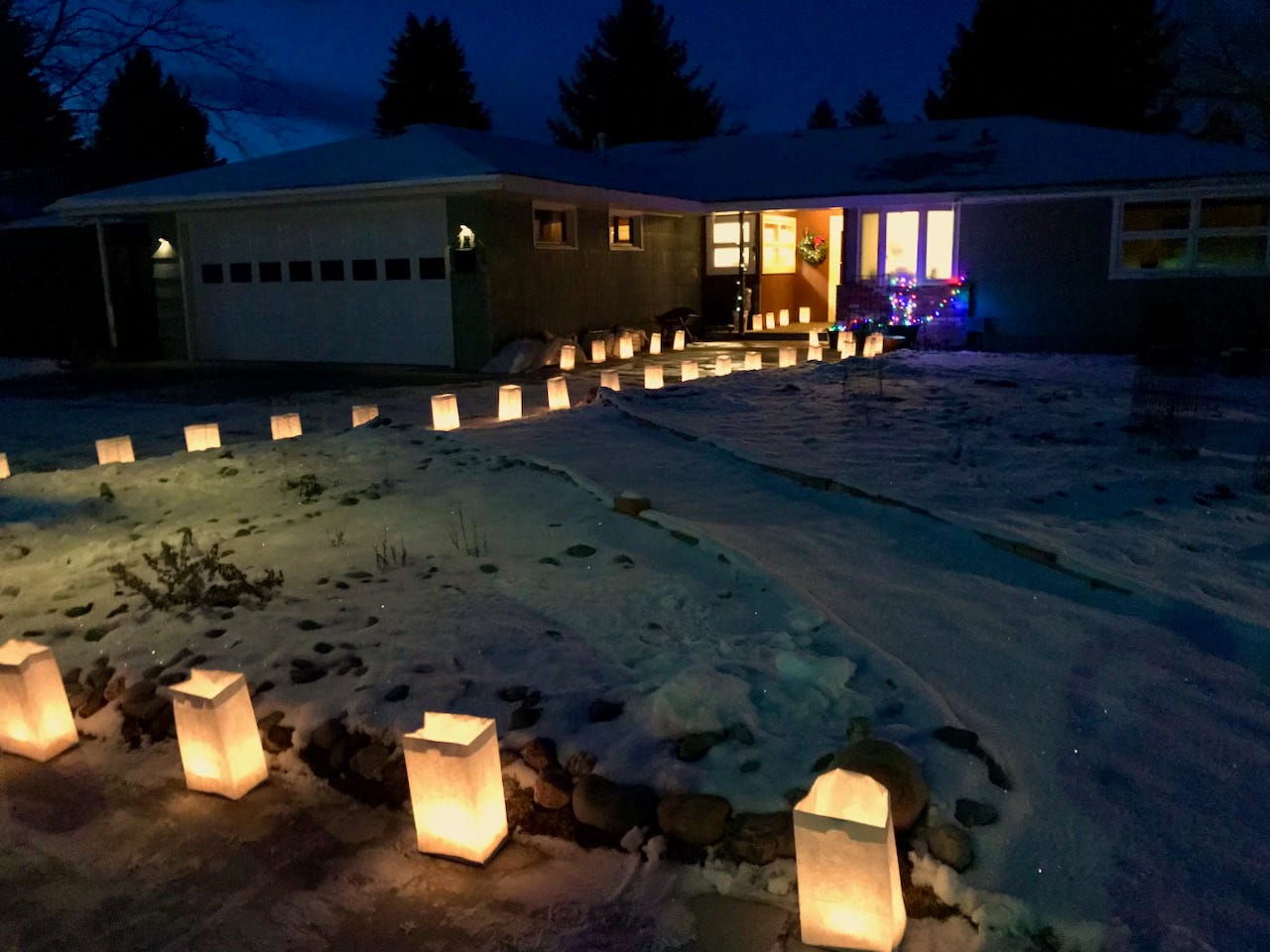
Make a vow when Solstice comes
to find the light in everyone.
—Mary Chapin Carpenter, “The Longest Night of the Year”
Hello Friends,
We’re two days from Winter Solstice here in the Northern Hemisphere, the longest night of the year. (Solstice falls on Saturday, December 21st this year.) After that, the days will gradually lengthen and the nights grow shorter as our hemisphere begins its annual tilt toward light and new life. (If you’re in the Southern Hemisphere, Saturday marks the Summer Solstice, the longest day of the year.)
As someone who identifies with plants and is thus day-length sensitive, I am grateful that the light will be returning soon!
A Tilted Planetary Axis
Winter Solstice and Summer Solstices are the hinges of the solar year, when one hemisphere tilts toward or away from the sun. These profound shifts are artifacts of our planet’s orientation: As Earth orbits the sun, our planet’s axis, an imaginary line running through the North and South poles, tilts 23 degrees off vertical.
That tilt means the hemispheres trade off their time in the sun: The Southern Hemisphere leans toward the sun for half the year, while the Northern Hemisphere leans away. For the other half the year, it’s the Northern Hemisphere getting more sunlight and warmth while the Southern Hemisphere goes into its cold and dark time.
Earth’s orbital “lean” is why we have the seasons. The nearer you are to the Equator, the less pronounced effect of our planet’s tilted axis, and the more even the day length and less variable the seasons.
Winter Holidays Based on Light
The ebbing of daylight is one reason that winter holidays from many traditions involve light, including Noël, Christmas, Chanukah, Kwanzaa and others. The roots of these celebrations are in the millennia before electricity banished darkness with the flick of a switch and modern astronomy explained the reason for the sun’s apparent withdrawal.
Imagine how anxiously we must have watched the day length shorten in those days, wondering, hoping, praying for the return of the solar god of light and life!
Hush Time
There is opportunity in these short days and long nights, however viscerally uneasy they may make us: They are an invitation to step off the treadmill of achieving, to slow our busyness and be more contemplative. There is a kind of inner stillness in this season that can be restorative if we let ourselves take advantage of it. That’s not necessarily easy.
A friend said recently that he is finally learning to adapt the rhythm of his life to the season, resting and reading more, instead of trying to “push through” and make himself stay productive during the dark days. “It’s helping,” he commented. “I feel better, less caught in the winter blues.”
I am working at slowing my rhythm to fit the season too, although it is not easy to convince my Type A, inner Chihuahua to relax. This year, I’m going to implement “hush time” for the days between Winter Solstice and New Year’s, as Sue Kusch describes it in her newsletter:
In Beth Kempton’s book and podcast, A Calm Christmas and a Happy New Year, she introduces the “Hush”—the days between Christmas and the New Year—as a time to “wrap yourself in the cloak of late December.”
I love this idea and have adopted the practice of savoring the Hush… during the last weeks of December.
Lighting the Darkness
I celebrate Winter Solstice and the longest night with luminarias, small paper bags with votive candles sitting on a scoop of sand. (They are called farolitos in northern New Mexico.) I line my porch and walkways with luminarias, and then light each candle, one by one. Those fragile paper bags glow all night long, lit by the tiny candles on their bed of sand, illuminating the year’s longest night.
You can make your own luminarias: All you need are paper lunch bags, clean sand, and 10-hour votive candles. Fold the top of each bag over toward the outside to make a sturdy collar to hold the bag open so it won’t blow into the flame and catch fire. Add about a cup of sand to the bottom of each bag to anchor it and then place one candle in the sand.
Set each luminaria outside on a non-flammable surface, light the wick and witness the miracle of ordinary materials—a tiny candle, sand and a fragile paper bag—glowing through the longest night, offering their light to chase away the darkness.
In the spirit of Hush time, I’m taking next week off. I’ll be back on January 2nd with a post on what I learned from my Year of Spiritual Thinking and what’s coming in this newsletter.
Solstice Blessings, and Happy New Year!






As an active reader - Type A Chihuahua myself - I like to search the locations and natural features of places the author mentions. NE New Mexico? SW Colorado? The San Juan Mountains helped in my search. At least three peaks over 14,000 feet altitude, with some cool temperatures at present. Brrr. Luminaria lend a magical quality to the dead of winter I would agree. A chill out period from Winter Solstice to the New Year feels compelling, Susan. I so appreciate your gentle messaging. Many thanks and see you next year…virtually.
It's the quiet of the dark that I find the most soothing. May your hush time fill you with sweet dreams. Happy holidays dear woman.